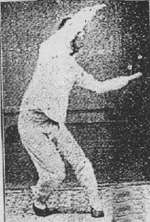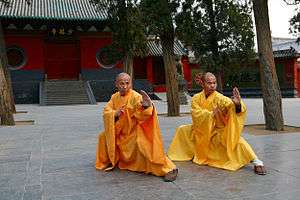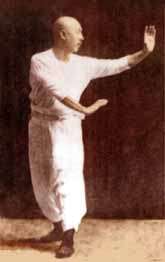Baguazhang
Baguazhang or Pakwachang (Chinese: 八卦掌; pinyin: Bāguà Zhǎng) is one of the three main Chinese martial arts of the Wudang school, the other two being T'ai chi and Xing Yi Quan. It is more broadly grouped as an internal practice (or neijia quan). Bāguà zhǎng literally means "eight trigram palm," referring to the trigrams of the I Ching (Yijing), one of the canons of Taoism.[1][2]
 Sun Lu-t'ang performing "Lion Embraces the Ball". | |
| Also known as | Bagua quan, Bagua zhang, Pakua chang, Pa-kua chang, Pakwachang |
|---|---|
| Hardness | Internal (neijia) |
| Country of origin | China |
| Creator | Dong Haichuan 董海川 (attributed) |
| Famous practitioners | Yin Fu, Cheng Tinghua, Ma Gui, Liang Zhenpu, Fu Chen Sung, Gao Yisheng, Jiang Rong Qiao, Sun Lutang, Jet Li |
| Olympic sport | No |
| Part of a series on |
| Chinese martial arts (Wushu) |
|---|
 |
| Wushu in the world |
|
Historical locations
|
| Wushu athletes/practitioners |
|
Legendary figures
|
|
Historical individuals
|
|
Modern celebrities
|
| Wushu influence |
History
The creation of Baguazhang as a formalized martial art, is attributed to Dong Haichuan (董海川), who is said to have learned from Taoist and Buddhist masters in the mountains of rural China during the early 19th century.[3] Many Chinese authorities do not accept the Buddhist origin, instead maintaining that those teachers were purely Taoist in origin, the evidence lying in Baguazhang's frequent reference to core concepts central to Taoism, such as Yin and Yang theory, I Ching and Taoism's most distinctive paradigm, the Bagua diagram.[4] The attribution to Buddhist teachers came from the 2nd generation teachers, i.e. Dong Haichuan's students, some of whom were Buddhist. There is evidence to suggest a synthesis of several pre-existing martial arts taught and practised in the region in which Dong Haichuan lived, combined with Taoist circle walking. Through his work as a servant in the Imperial Palace he impressed the emperor with his graceful movements and fighting skill, and became an instructor and a bodyguard to the court.[5] Dong Haichuan taught for many years in Beijing, eventually earning patronage by the Imperial court.[6]
Famous disciples of Dong Haichuan to become teachers were Yin Fu (尹福), Cheng Tinghua (程廷華), Ma Gui (馬貴), Song Changrong (宋長榮), Liu Fengchun (劉鳳春), Ma Weiqi (馬維棋), Liu Baozhen (劉寶珍), Liang Zhenpu (梁振蒲) and Liu Dekuan (劉德寛). Although they were all students of the same teacher, their methods of training and expressions of palm techniques differed.[2] The Cheng and Liu styles are said to specialize in "pushing" the palms, Yin style is known for "threading" the palms, Song's followers practice "Plum Flower" (梅花 Mei Hua) palm technique and Ma style palms are known as "hammers." Some of Dong Haichuan's students, including Cheng Tinghua, participated in the Boxer Rebellion. In general, most bagua exponents today practice either the Yin (尹), Cheng (程), or Liang (梁) styles, although Fan (樊), Shi (史), Liu (劉), Fu (傅), and other styles also exist. (The Liu style is a special case, in that it is rarely practiced alone, but as a complement to other styles). In addition, there are sub-styles of the above methods as well, such as the Sun (孫), Gao (高), and Jiang (姜) styles, which are sub-styles of Cheng method.
Modern styles
- Yin Style: Yin Fu (尹福)
- Cheng Style: Cheng Tinghua (程廷華)
- Liang Style: Liang Zhenpu (梁振蒲)
- Gao Style: Gao Yisheng (高義盛)
- Yin Sect Gao Style: Gao Ziying (高子英)
- Jiang Style: Jiang Rong Qiao (姜容樵)
- Shi Style: Shi Jidong (史計棟)
- Song Style: Song Changrong 宋長榮 and Song Yongxiang (宋永祥)
- Fan Family Style: Fan Zhiyong (范志勇)
- Liu Style: Liu Baozhen (劉寶珍)
- Ma Style: Ma Weiqi (馬維棋)
- Ma Gui Style: Ma Gui (馬貴)
- Gong Baotian Style: Gong Baotian (宮寶田)
- Sun Style: Sun Lutang (孫祿堂)
- Fu Style: Fu Zhensong (傅振嵩)
- Yin Yang Style (Tian Style): Tian Hui (田廻)
- Ho Ho Choy Baguazhang: He Kecai (何可才)
Common aspects

The practice of circle walking, or "turning the circle", as it is sometimes called, is Baguazhang's characteristic method of stance and movement training. All forms of Baguazhang utilize circle walking as an integral part of training. Practitioners walk around the edge of the circle in various low stances, facing the center, and periodically change direction as they execute forms.[7] For a beginner, the circle is six to twelve feet in diameter.[5] Students first learn flexibility and proper body alignment through the basic exercises, then move on to more complex forms and internal power mechanics. Although the internal aspects of Baguazhang are similar to those of Xingyiquan and Taijiquan, they are distinct in nature.
.jpg)
Many distinctive styles of weapons are contained within Baguazhang; some use concealment, like the "scholar's pen" or a pair of knives (the most elaborate, which are unique to the style, are the crescent-shaped deer horn knives (Chinese: 鹿角刀; pinyin: Lùjiǎodāo). Baguazhang is also known for practicing with extremely large weapons, such as the bāguà jian (八卦劍), or bagua sword, and the bāguà dāo (八卦刀), or bagua broadsword. Other, more conventional weapons are also used, such as the staff (gun), spear (qiang), cane (guai), hook sword (gou) and the straight, double-edged sword (jian). Baguazhang practitioners are also known for being able to use anything as a weapon using the principles of their art.
Baguazhang contains an extremely wide variety of techniques as well as weapons, including various strikes (with palm, fist, elbow, fingers, etc.), kicks, joint locks, throws, and distinctively evasive circular footwork. As such, Baguazhang is considered neither a purely striking nor a purely grappling martial art. Baguazhang practitioners are known for their ability to "flow" in and out of the way of objects. This is the source of the theory of being able to fight multiple attackers.[8][9][10] Baguazhang's evasive nature is also shown by the practice of moving behind an attacker, so that the opponent cannot harm the practitioner.
Although the many branches of Baguazhang are often quite different from each other (some, like Cheng style, specialize in close-in wrestling and joint locks, while others, like some of the Yin styles, specialize in quick, long-range striking), all have circle walking, spiraling movement, and certain methods and techniques (piercing palms, crashing palms, etc.) in common.
Baguazhang's movements employ the whole body with smooth coiling and uncoiling actions, utilizing hand techniques, dynamic footwork, and throws. Rapid-fire movements draw energy from the center of the abdomen. The circular stepping pattern also builds up centripetal force,[11][12][13] allowing the practitioner to maneuver quickly around an opponent.[14][15][16]
In popular culture
- Airbending in Avatar: The Last Airbender (2005–2008) and The Legend of Korra (2012–2014) is modeled on Baguazhang.[17]
- Gentle Fist in Naruto (1999–2013) and Boruto: Naruto Next Generations is modeled on Baguazhang and Dim Mak, fighting style of Hyuga clan.
- In the 2003 American TV series Black Sash, the protagonist Tom Chang (Russell Wong) has a Chinese martial arts school where he trains his students in "the art of 8 palm changes", Baguazhang.
- The video game characters Ashrah from Mortal Kombat: Deception and Kitana from Mortal Kombat: Deadly Alliance use Baguazhang.
- Ling Xiaoyu from the Tekken video game series uses Baguazhang.
- In the 2000 movie Crouching Tiger, Hidden Dragon, the police inspector Tsai was dueling with Jade Fox using a pair of deer horn knives, a weapon typical of the Baguazhang system.
- Jet Li's character in the 2001 movie The One uses Baguazhang, while the antagonist version of the character uses Xingyiquan
- In the 2006 movie Jadesoturi (Jade Warrior), in the Pin Yu vs Sintai fight, they used Baguazhang as a sort of courting.
- In the 2010 movie sequel Ip Man 2, one of the styles used during the tabletop fight is Baguazhang.
- In the 2009 live-action film Tekken, Jin Kazama says that he is impressed by fellow competitor Christie Monteiro due to her foot placement while practicing Baguazhang.
- In the 2012 movie sequel Tai Chi Hero, the final fights were against Baguazhang disciples and master.
- The 2013 Hong Kong martial arts movie The Grandmaster featured a Northern Chinese martial arts style called the 64 Hands, used by Zhang Ziyi's character Gong Er, which featured the circle walking and elaborate palm changes of Baguazhang.
- In the manga Kenji, the protagonist Kenji uses Baguazhang when dueling the main antagonist Xingyi Liuhequan practitioner Tony.
- Baguazhang features briefly in the manga History's Strongest Disciple Kenichi.
- Qu Tuang from the manga Battle Angel Alita: Last Order uses a style based on Baguazhang called "Ahat Mastade" that is meant for fighting in zero gravity.
- Joscelin Verreuil from Jacqueline Carey's Kushiel's Legacy fantasy novels series uses a fighting style similar to Baguazhang, which is the fighting style of the Cassiline Brotherhood.
- The student number twelve, Ku Fei from Negima! Magister Negi Magi, according to herself, on chapter 55 of the manga, Baguazhang is one of the specialties together with Tai chi chuan, she also said she knows a little of shinitai gouken and hakkyokuken.
See also
Notes
- Rousseau, Robert (2017-05-22). "An Introduction to Chinese Martial Arts Styles". Retrieved 2017-06-01.
- Lie, Zhang. “Classical Baguazhang Volume V: Yin Style Baguazhang.” Trans. Joseph Crandall. Pinole, California: Smiling Tiger Martial Arts 1995.
- Yintao, Fei and Yuliang, Fei. “Classical Baguazhang Volume IV: Wudang Baguazhang.” Trans. Joseph Crandall. Pinole, California: Smiling Tiger Martial Arts 1994.
- Liang, Shou-Yu; Yang, Jwing-Ming; Wu, Wen-Ching; Jwing-Ming, Yang (1994). Baguazhang: Emei Baguazhang Theory and Applications. YMAA Publication Center. ISBN 978-0-940871-30-4.
- Green, Thomas A. "Martial Arts of the World" 2001
- Jingru, Liu and Youqing, Ma. “Classical Baguazhang Volume II: Cheng Shi Baguazhang (Cheng Family Baguazhang).” Trans. Joseph Crandall. Pinole, California: Smiling Tiger Martial Arts 2001.
- Lie, Zhang. Classical Baguazhang Volume V: Yin Style Baguazhang. Trans. Joseph Crandall. Pinole, California: Smiling Tiger Martial Arts 1995.
- "Ba Gua Zhang (Pa Kua Chang)". Brisbane Kung Fu. Retrieved 2017-06-01.
- "FAQ 3) Martial arts". Magui Baguazhang Promotion Center. 2015. Retrieved 2017-06-01.
- "INNER SECRETS - Martial arts and Health". Archived from the original on 2014-03-01. Retrieved 2017-06-01.
- "Baguazhang | 八卦掌". Taiping Institute. 2015. Retrieved 2017-06-01.
- Su Dong-Chen (July 2008). "Spiral Body Ba Gua Zhang". Archived from the original on 2016-11-07. Retrieved 2017-06-01.
- Dan Huan Zhang (2017-03-13). "SINGLE PALM CHANGE". Retrieved 2017-06-01.
- Ba Gua Zhang (2012-05-07). "AN INTRODUCTION TO BA GUA ZHANG". Retrieved 2017-06-01.
- "Baguazhang: 8 trigrams palm". 2017-01-13. Retrieved 2017-06-01.
- Matthews, Paul (2013-11-29). "Bagua-a fighting art designed for multiple attackers". Retrieved 2017-06-01.
- "Martial Arts". AvatarSpirit.net. 2016. Retrieved 2017-06-01.
References
- Robert W. Smith, Chinese Boxing, ISBN 1-55643-085-X
- Bok Nam, Park & Dan Miller, The Fundamentals of Pa Kua Chang: The Methods of Lu Shui-T'ien As Taught by Park Bok Nam, ISBN 0-86568-173-2
- Shou-Yu, Liang, Baguazhang : Emei Baguazhang Theory and Applications, ISBN 0-940871-30-0
- O'Brien, Jess, Nei Jia Quan: Internal Martial Arts Teachers of Tai Ji Quan, Xing Yi Quan, and Ba Gua Zhang, ISBN 1-55643-506-1
- Frantzis, Bruce Kumar, The Power of Internal Martial Arts: Combat Secrets of Ba Gua, Tai Chi, and Hsing-I, ISBN 1-55643-253-4
- Wang Shujin, Bagua Linked Palms - Translated by Kent Howard and Chen Hsiao-Yen, ISBN 978-1-58394-264-2 (1-58394-264-5)
- Wang Shujin, Bagua Swimming Body Palms - Translated by Kent Howard and Chen Hsiao-Yen, ISBN 978-1-58394-245-1 (1-58394-245-9)
External links
| Wikimedia Commons has media related to Baguazhang. |